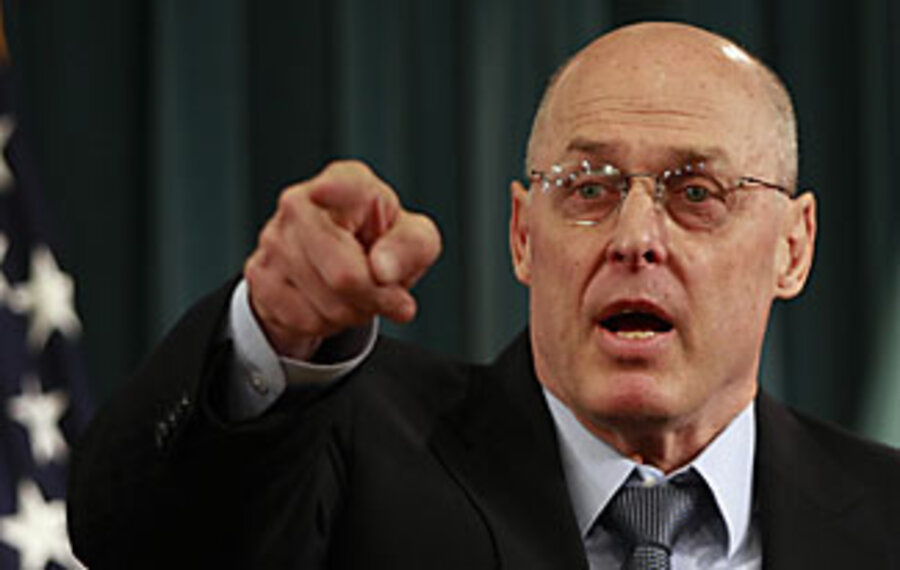US unveils new $800 billion plan to loosen credit
| Washington
Right now, the US Treasury and the Federal Reserve are like plumbers determined to get water flowing again through a system of clogged pipes. Each time they think they've got things working, another faucet stops up, and they have to drag out new and bigger tools to address the latest aspect of the ongoing US financial crisis.
In their most recent effort, the Treasury and the Fed on Tuesday unveiled a pair of programs intended to provide $800 billion to help unfreeze consumer lending. Such credit essentially came to a halt in October, according to Treasury Secretary Henry Paulson, threatening already battered retail and housing markets with grave further damage.
In essence, the US government may be trying to bypass banks and get money to consumers in a somewhat more direct manner. It's just the latest surprise in a rescue effort that's had many – and will probably have more.
"It's not a simple procedure, unclogging the banking system," says Doug Roberts, chief investment strategist at ChannelCapitalResearch.com.
Under a new Fed program for consumer debt, the US government will lend up to $200 billion to financial institutions that hold securities backed by various types of consumer loans such as credit cards and auto and student loans. The goal is to provide greater demand for these securities, which in turn should make more money available to the consumer loan market, in the end leading to lower consumer interest rates.
That's the plan, anyway.
"This is aimed at increasing the availability of affordable lending," said Secretary Paulson at a briefing for reporters.
This new Term Asset-Backed Securities Loan Facility, or TALF, will be supported by $20 billion of equity backing from the Treasury's $700 billion Troubled Asset Rescue Program, known familiarly in Washington as TARP.
He also announced a separate $600 billion effort to buy up mortgage-backed assets in an effort to get money flowing in mortgage markets again, at lower rates.
As much as $100 billion of this program will go for purchases of assets from mortgage giants Fannie Mae and Freddie Mac, and the Federal Home Loan Bank. The rest will be used to buy mortgage-backed securities, the now-infamous pools of mortgages – some of them shaky – that were bundled together and sold to investors.
The current financial situation is historic and unpredictable, said Paulson.
The Treasury chief added that he knows many people wish there were a single action the US government could take, or a single bill that Congress could pass, to fix the situation. But there isn't, he said.
"We're developing the programs we think will be the most effective," said Paulson.
Underscoring the fragility of the overall US economy, data released Tuesday showed that the US gross domestic product shrank at a 0.5 percent rate in the July-to-September quarter, worse than the 0.3 percent of decline first estimated by the Commerce Department a month ago.
Meanwhile, the Standard & Poor's/Case-Shiller national home price index released Tuesday fell a record 16.6 percent from a year previously. Nationally, housing prices are at levels not seen since the first quarter of 2004.
That, in turn, has made it difficult for consumers to borrow. The consumer-asset backed securities market declined steeply in the third quarter and essentially came to a halt in October, according to Paulson.
That's why the government felt it had to intervene yet again, jumping into this market, says Bob Eisenbeis, chief monetary economist for Cumberland Advisors in Vineland, N.J.
"This is another manifestation of 'We'll do whatever it takes,' " says Mr. Eisenbeis.
The Fed's primary tool for getting money flowing in US credit markets is reducing the interest rates it controls, says Eisenbeis. But those rates are now near zero, greatly lessening the utility of further cuts.
"There are other mechanisms you can use to inject liquidity into the marketplace, like buy assets, and that's the way I interpret these programs," he says.
The Fed and the Treasury are in essence bypassing the banking system with these programs, and trying to get more money into consumers' pockets.
But they're still not dealing with consumers as directly as they could, according to an analysis by Robert Brusca, chief economist at Fact and Opinion Economics.
For instance, the "Fed is not making mortgage loans to individuals. It is not giving them financing," writes Mr. Brusca.
Instead, it is buying up old mortgage securities, in hopes "institutions will feel better and will lend or buy more asset-backed paper," according to Brusca.
Some Democratic lawmakers who have been critical of the Bush administration's rescue efforts in the past praised the programs unveiled Tuesday, saying too much of the government's past efforts were focused on Wall Street.
"This new focus by Treasury and the Fed should help inject some much-needed economic life into Main Street and couldn't come a day sooner," said Sen. Charles Schumer (D) of New York in a statement.
• Associated Press material was used in this report.






